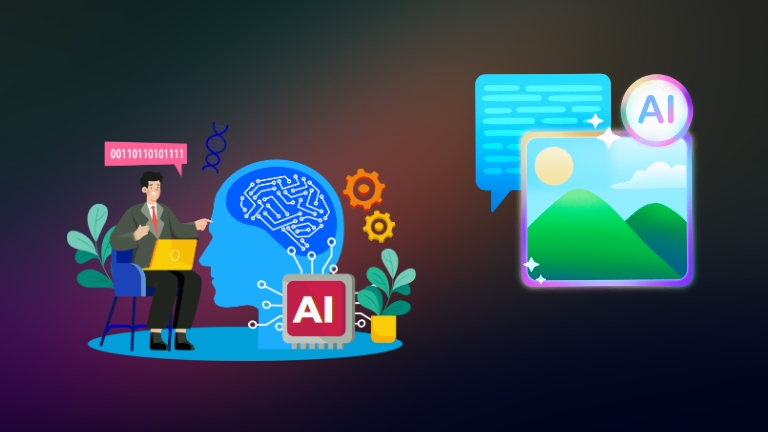In 2020, generative AI was still a novelty, fascinating, yet limited to research labs and a few creative tools. Fast forward to 2025, and it’s everywhere: composing music, creating ads, developing software code, even running customer support. What once sounded futuristic is now foundational. But beyond the headlines, what do the numbers say? In this article, we’ll walk through the latest statistics that show how deeply generative AI has embedded itself into industries, tools, and workflows.
Whether you’re a marketer, developer, founder, or just curious about where this technology is headed, the data below offers a lens into the generative AI revolution unfolding this year.
Editor’s Choice
- 4,800 new generative AI tools have launched globally in 2025, marking a 35% increase from last year.
- 58% of all digital content in 2025 is now generated by AI models.
- 72% of social media managers in the US regularly use generative AI to create content.
- The number of patent filings related to generative AI has surpassed 12,400 in 2025.
- 82% of enterprise teams report they’ve implemented prompt engineering training programs in 2025.
- 64% of AI models released this year are open-source, while 36% are proprietary, showing an ongoing shift in the AI ecosystem.
- Fine-tuned models now power 49% of all deployed generative AI applications in 2025.
Generative AI Market Set for Explosive Growth
- The Generative AI market is on course to hit a staggering $255.8 billion by 2033.
- From just $13.5 billion in 2023, the market is expected to nearly double every few years, reaching $58.8 billion by 2028.
- By 2030, it’s forecasted to more than quadruple, climbing to $105.8 billion.
- The growth curve steepens into 2032, with projections pointing to $190.6 billion.
- A robust 34.2% CAGR signals fast-paced adoption, massive investments, and a rapidly evolving landscape.
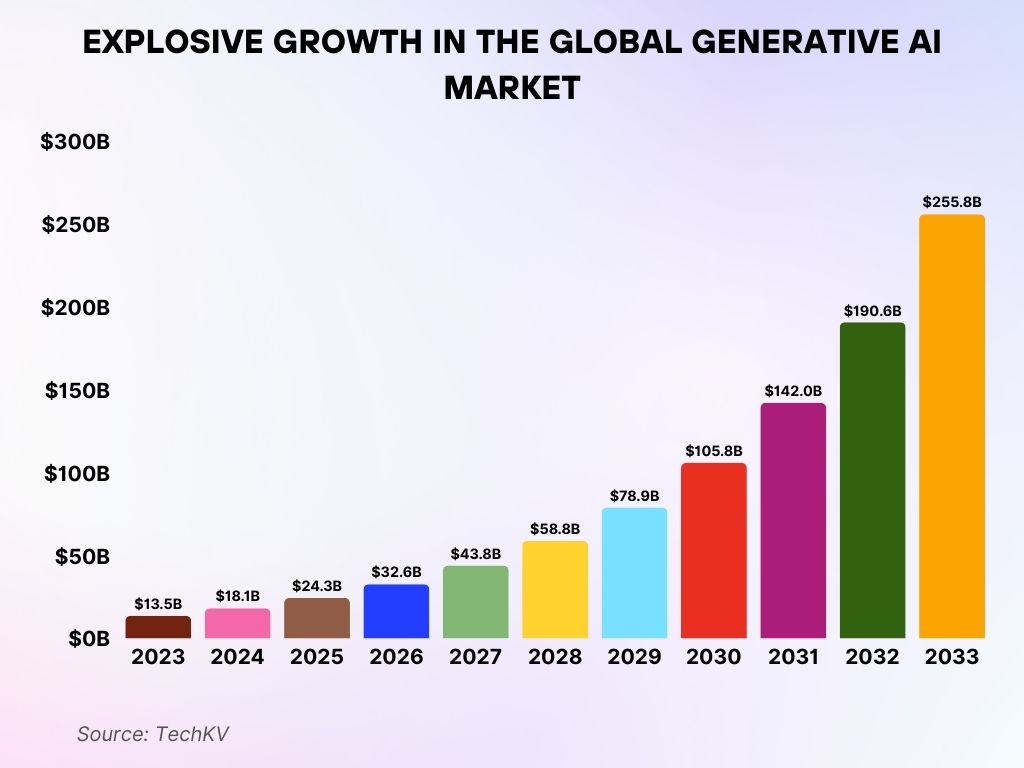
Number of Generative AI Tools Released Annually
- In 2025, more than 4,800 generative AI tools were introduced.
- On average, 13 new tools are released daily this year, a record pace of development.
- The top three categories of these tools include content generation (42%), code assistance (28%), and customer service automation (18%).
- The US and India account for 61% of new tool launches in 2025, showcasing their dominance in the AI startup scene.
- Of these tools, over 74% now offer multilingual support, addressing the global user base.
- API-first generative tools represent 36% of all new launches, making integration easier for developers.
- Approximately 47% of 2025’s tool releases come with built-in compliance features (such as GDPR support).
- Nearly 68% of these new tools incorporate some form of image or video generation, showing the multimodal trend.
- Open-source toolkits like LangChain and Hugging Face Spaces are embedded in more than half of the new tools launched this year.
- Generative AI platforms offering auto-fine-tuning capabilities upon onboarding grew by 29%.
AI-Generated Content Volume
- As of 2025, 58% of the world’s digital content is AI-generated.
- In the US alone, 33 million blog posts are expected to be written by AI this year.
- AI-generated images shared online hit 6.2 billion in the first half of 2025.
- About 71% of business newsletters now include at least one AI-written section.
- 92% of Fortune 500 companies use AI to generate internal reports and dashboards.
- The average YouTube channel using AI sees 18% faster content turnaround, according to user benchmarks in early 2025.
- On TikTok, videos tagged with #AI-generated have received over 94 billion views as of July 2025.
- Over 83% of e-commerce platforms deploy AI to generate product descriptions in real time.
- Generative AI accounts for 61% of content created by freelancers on major platforms like Upwork and Fiverr.
- Across all channels, AI is responsible for creating 15 times more content in 2025 than in 2020.
Top Predicted Generative AI Use Cases
- Customer service chatbots top the chart, with 28% of respondents expecting the most value from this use case.
- Business process workflow management comes next at 21%, showing strong potential for automation and efficiency gains.
- Customer service support remains a vital application, valued by 19%, highlighting continued AI integration in support operations.
- Market research/customer insights and customer communications are tied at 18%, reflecting growing demand for data-driven engagement.
- Software code generation and translation also hit 18%, showcasing AI’s expanding role in development environments.
- Planning, budgeting, and forecasting follow at 17%, pointing to GenAI’s usefulness in strategic decision-making.
- Both supply chain optimization and regulatory compliance/documentation are valued by 16%, indicating AI’s impact on logistics and legal tasks.
- Contact center management and monitoring rounds out the list at 15%, still a noteworthy area for GenAI implementation.
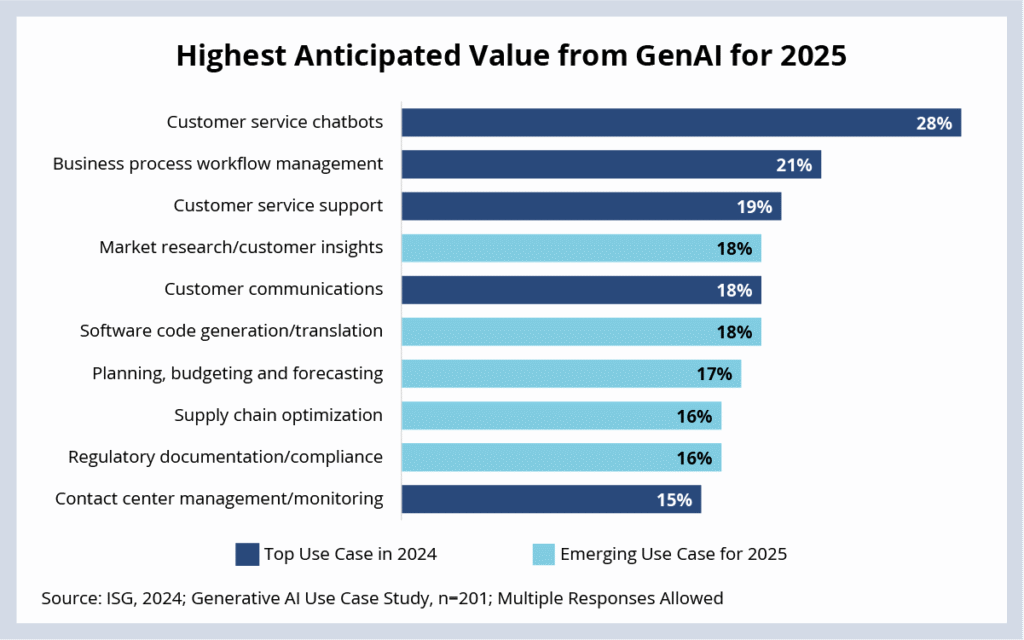
Generative AI Usage in Social Media Platforms
- 72% of social media professionals use generative AI tools at least weekly in 2025.
- Meta’s tools, including Llama-powered content generators, have seen adoption by 48% of Instagram’s verified business accounts.
- AI-generated posts now account for 33% of Twitter/X’s trending content in any given week.
- 61% of influencers report using AI to draft captions or scripts in 2025.
- LinkedIn AI-generated job post suggestions are used in over 1.4 million listings per month.
- Pinterest has introduced generative idea pins, and 27% of creators have adopted them since rollout in Q2 2025.
- AI-driven meme generators were responsible for 920 million meme shares across platforms this year.
- Snapchat’s AI filters with generative visual overlays saw 29% higher engagement than traditional filters.
- Among Gen Z users, 39% say they prefer AI-generated posts for daily updates over human-written ones.
- AI-generated audio for Reels and TikToks accounts for 22% of top-trending sounds in 2025.
Patent Filings Related to Generative AI
- Over 12,400 patents related to generative AI were filed globally in 2025.
- The US Patent and Trademark Office (USPTO) received 5,100 of these applications, nearly half of the global total.
- China and South Korea followed closely, filing 2,800 and 1,300 patents, respectively.
- Patent filings involving multimodal generation (text + image + audio) made up 27% of total filings.
- NLP model training optimization patents rose by 63%, highlighting efficiency innovation trends.
- Generative AI patents in healthcare applications surged by 88%, particularly in diagnostic imaging and report summarization.
- AI art copyright mechanisms emerged as a new subcategory, with 430 filings recorded in 2025.
- Patents related to AI safety layers and alignment techniques grew by 74% year-over-year.
- 10% of patent filings now come from cross-sector collaborations, including between academic labs and private AI firms.
- The average time-to-approval for generative AI patents has dropped to 18 months, down from 26 months in 2022.
Regional Breakdown of Generative AI Market Share
- North America takes the lead with a commanding 41% share, driven by heavy tech investment and cutting-edge innovation.
- Europe secures the second spot at 26%, showcasing broad adoption across industries from finance to manufacturing.
- Asia Pacific holds 22%, underscoring the region’s rapid digital growth and AI acceleration in emerging economies.
- Latin America makes up 8% of the market, reflecting steady progress but a more measured pace of adoption.
- Middle East & North Africa trails with just 3%, suggesting early-stage adoption and room for future expansion.
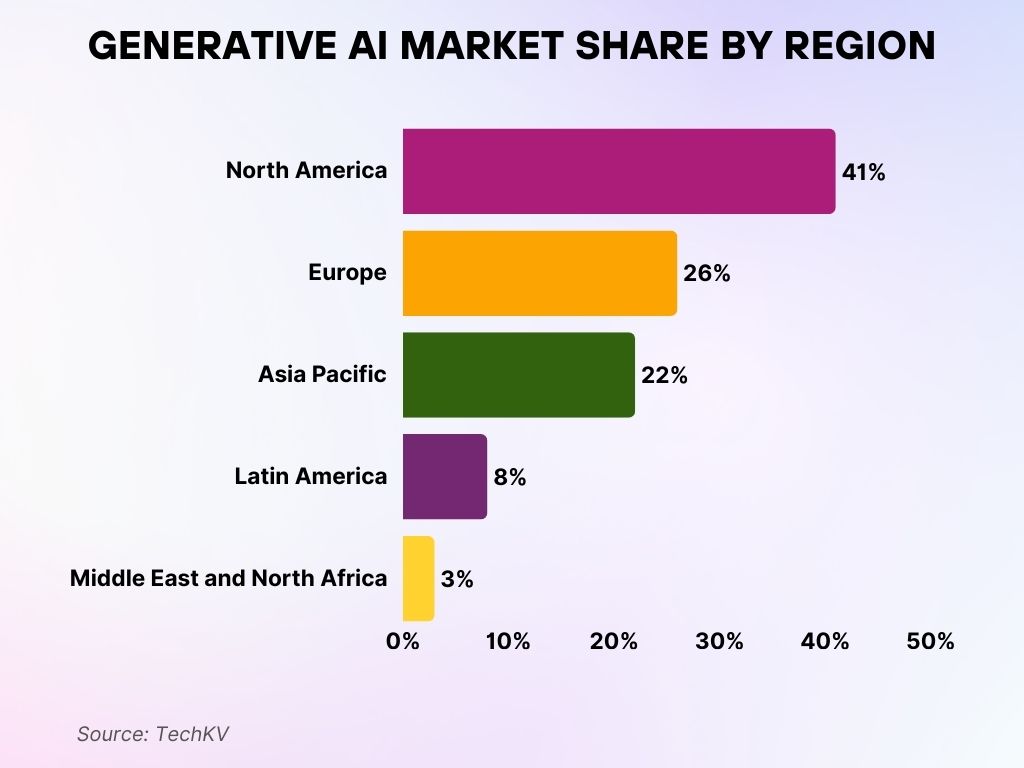
Frequency of Prompt Engineering Practices
- In 2025, 82% of companies deploying LLMs train staff in prompt engineering.
- Prompt libraries, shared collections of optimized prompts, are used by 61% of enterprise teams.
- 46% of software engineers now list “prompt engineering” as a skill on LinkedIn, showing its mainstream status.
- Dedicated prompt engineering roles have increased by 140% year-over-year in 2025 job postings.
- Prompt marketplaces, such as PromptBase and FlowGPT, have reached 3.6 million users in 2025.
- The average team modifies their prompts 5.7 times per project to achieve optimal model responses.
- 35% of LLM performance issues in enterprise systems are now attributed to prompt quality.
- Pre-trained prompt modules are included in 58% of generative AI platforms by default.
- Generative AI tools with prompt suggestion assistants see a 22% higher user success rate.
- More than 190 universities worldwide now offer courses or certifications in prompt engineering as of mid-2025.
Open-Source vs Proprietary Generative AI Models
- As of 2025, 64% of all newly released generative AI models are open-source, up from 51% last year.
- The Hugging Face platform hosts over 155,000 open-source models.
- 36% of new models in 2025 are proprietary, often bundled with SaaS platforms.
- Open-source models outperform proprietary ones in 38% of standardized NLP benchmarks.
- 89% of AI startups report they use open-source foundations before adding proprietary fine-tuning layers.
- 11 of the top 15 commercial chatbots run on fine-tuned open-source backbones in 2025.
- GitHub repos related to open-source generative AI projects saw 127% growth this year.
- Licensing concerns remain: 24% of enterprise teams cite unclear model usage rights as a challenge.
- Open-weight models are used in 58% of academic papers on generative AI in 2025.
- The cost to adopt open-source generative AI models is 72% lower on average than proprietary solutions.
How College Students Are Using AI for Academic Work
- A notable 55.4% of college students have used AI tools for assignments or exams, showing how deeply AI is woven into academic life.
- Meanwhile, 40.6% say they haven’t used AI, reflecting a sizeable group still relying on traditional study methods.
- A small 4% preferred not to answer, possibly pointing to privacy concerns or uncertainty about academic rules around AI use.
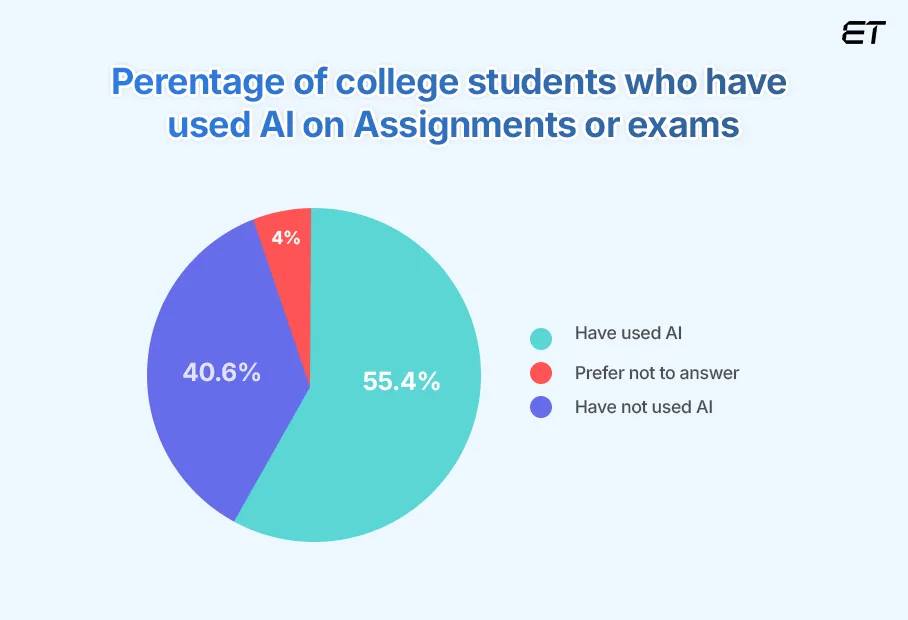
Fine-Tuning and Custom AI Model Usage
- In 2025, 49% of deployed generative AI apps use fine-tuned models.
- Companies that fine-tune models report 28% higher task accuracy than those using base models.
- Custom-trained models are used in 62% of generative AI enterprise applications this year.
- The average fine-tuning dataset size has grown to 4.2 million parameters per domain-specific model.
- Fine-tuning costs have dropped by 45% compared to 2023 due to more efficient optimization routines.
- Healthcare and legal tech are the leading sectors for fine-tuned generative AI models.
- Auto-fine-tuning tools, like Databricks Mosaic and OpenAI’s Custom GPTs, saw 3x usage growth in 2025.
- Federated fine-tuning, allowing decentralized learning without raw data sharing, grew 88% in adoption.
- Prompt + fine-tune hybrid models outperform base LLMs by 21% in enterprise Q&A benchmarks.
- Over 800 companies are now deploying private foundation models trained from scratch.
Computational Costs and Energy Consumption Metrics
- The average training run for a foundation model in 2025 consumes 1.2 GWh.
- Carbon emissions per training run dropped by 38% thanks to new GPU efficiency standards.
- Top LLM training facilities now use 72% renewable energy, compared to 41% two years ago.
- The cost to train a state-of-the-art model has stabilized at around $4.6 million, down from $8.1 million in 2022.
- Parameter-efficient training methods (like LoRA) have cut fine-tuning compute time by 56%.
- Edge inference models consume 93% less energy than full-scale cloud deployments per query.
- Real-time generative inference now costs $0.0025 per prompt on average.
- Major cloud providers offer carbon scorecards with each model deployment by default in 2025.
- AI accelerator chips like NVIDIA H200 and Google TPUv5 are 2.3x more efficient than previous-gen hardware.
- Model distillation, used to compress large models into smaller ones, reduces compute needs by 61%.
Most Widely Used Generative AI Tools Today
- ChatGPT dominates the field, with 55% of users naming it their top generative AI tool.
- Copy.ai comes in strong at 42%, cementing its spot as a content creation favorite.
- Jasper.ai is trusted by 36%, especially valued for its high-quality writing output.
- Peppertype.ai grabs 29% usage, showing rising appeal among content marketers and creators.
- Lensa, known for AI-powered photo editing, is used by 28% of respondents.
- DALL·E impresses 25% of users with its AI-generated image capabilities.
- MidJourney is close behind at 24%, gaining momentum in the world of visual content creation.
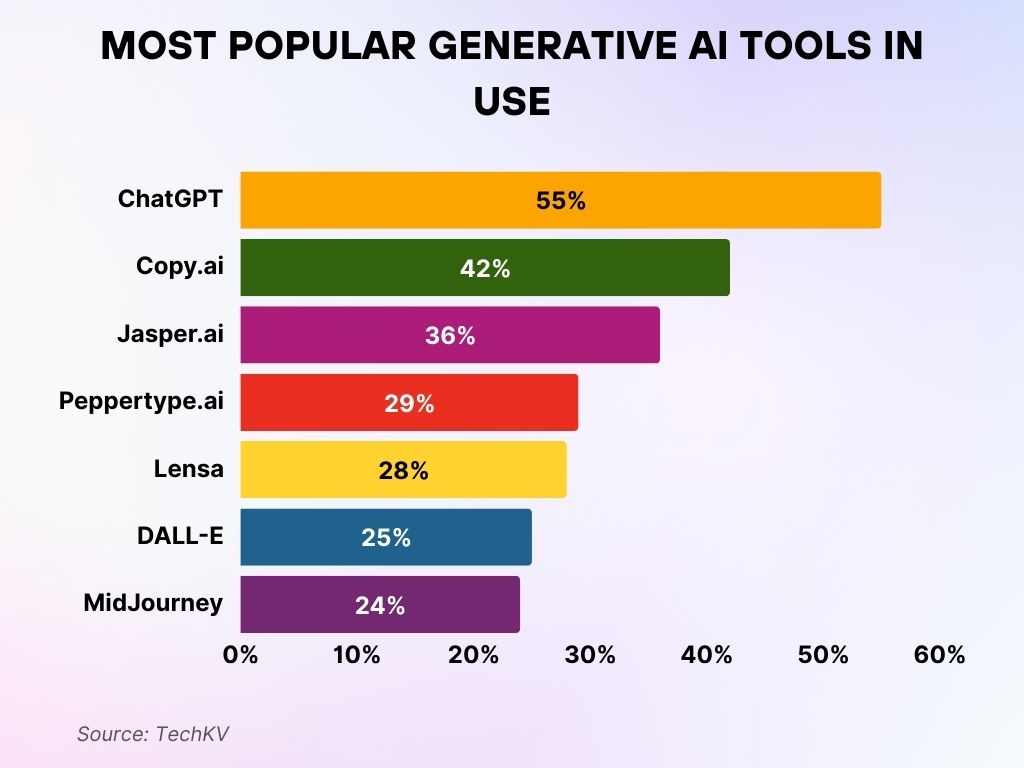
Multimodal Generative AI Adoption Trends
- In 2025, 37% of all generative AI applications are multimodal (text, image, audio, or video).
- 90% of new AI startups are building tools that support more than one modality.
- OpenAI’s GPT-5 and Google Gemini Ultra both support 4+ input types, including video and code.
- Multimodal search engines, like Perplexity and You.com, saw a 52% increase in monthly usage.
- Image-to-audio synthesis tools saw 290% growth among creative industries this year.
- Retail companies using multimodal AI for virtual try-ons reported a 31% higher conversion rate.
- Educational platforms incorporating video + text models have reduced drop-off rates by 22%.
- Multimodal medical diagnostics are now used by 18% of US hospitals, up from 7% last year.
- 51% of generative design apps in 2025 will let users input prompts across at least two modalities.
- The demand for multimodal training datasets surged by 73%, creating a bottleneck in AI research.
Data Privacy Incidents Linked to Generative AI
- In 2025, 41% of reported AI-related privacy breaches involved generative tools.
- Of those, 63% were due to inadvertent prompt leaks exposing sensitive data.
- Regulatory complaints about generative AI rose to 3,700 cases in the US alone.
- 24% of enterprises using gen AI have now integrated real-time redaction tools to filter prompts.
- The EU AI Act, effective this year, mandates disclosure of AI-generated outputs for all public-facing content.
- 37% of SaaS apps with built-in AI offer user-side control over data retention policies.
- In 2025, 5% of data privacy fines globally involved misuse of LLM-generated content.
- Major cloud providers offer AI-specific audit logs for enterprise clients to monitor usage risks.
- Awareness campaigns by governments led to 28% more reporting of AI data misuse incidents.
- New tools like AIInspect and PromptWatch are used by 42% of cybersecurity teams monitoring LLM systems.
AI Users by Experience: Who’s Using It and How
- 46.5% are AI Novices; they’ve dabbled with AI but still lack the know-how or consistency to use it effectively.
- 33.7% fall under AI Experimenters, using AI occasionally with basic prompts, but not yet seeing major benefits.
- 10.9% are AI Skeptics, either hesitant, uninterested, or having tried it and walked away.
- 7.9% are AI Practitioners, using AI weekly and experiencing real productivity gains in their workflows.
- Just 1% are true AI Experts, deeply knowledgeable in AI’s potential and pitfalls, using it for high-impact tasks.
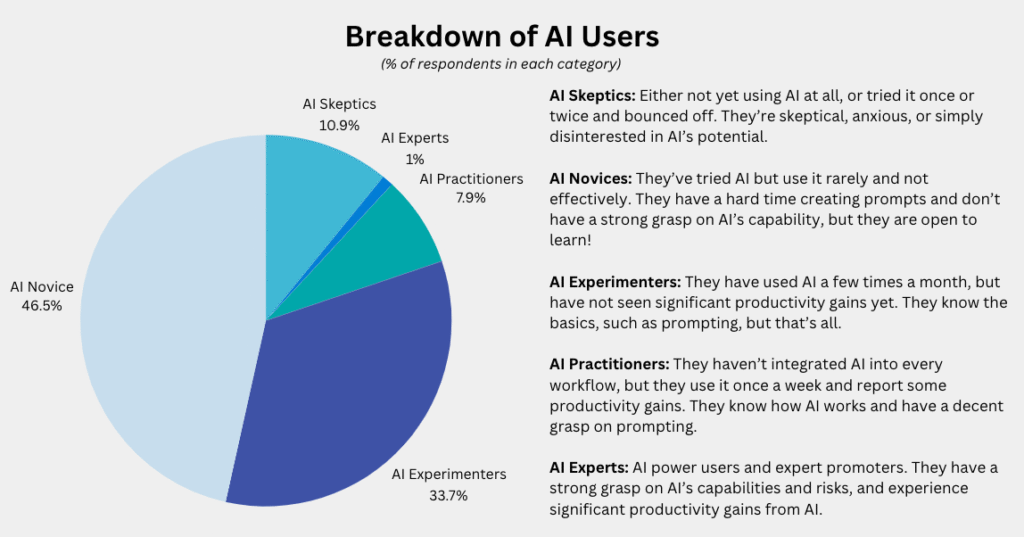
Regional Differences in Generative AI Deployment
- North America leads with 38% of all global generative AI investments made in 2025.
- China has seen a 61% year-over-year rise in gen AI deployments, driven by government-backed AI labs.
- India is now the third-largest market by developer activity in generative AI, with 1.9 million contributors.
- The EU prioritizes regulation-compliant AI, with 79% of European deployments meeting GDPR-aligned safety layers.
- Brazil has witnessed a 92% spike in generative AI startups, particularly in finance and education.
- In Japan, generative AI is used in 68% of enterprises for business document summarization and code review.
- South Korea’s gen AI integration into smart manufacturing rose by 44% compared to 2024.
- Middle East regions have invested over $3.4 billion in national-level AI infrastructure for language models.
- Africa saw a 3.2x growth in generative AI hackathons and grassroots innovation hubs in 2025.
- Multilingual model support expanded in Latin America, with 72% of tools now supporting Spanish and Portuguese natively.
Developer Engagement in Generative AI Ecosystems
- There are now over 4.6 million active developers working on generative AI projects globally in 2025.
- GitHub saw a 2.4x increase in generative AI repository contributions this year.
- 58% of open-source model fine-tuning scripts are now community-contributed.
- Hugging Face, the most active hub, has over 180,000 contributors across model-sharing repositories.
- 44% of Stack Overflow’s AI-tagged questions in 2025 are specific to generative models like GPT, Mistral, and Claude.
- The average developer now spends 23% of their coding hours integrating or testing generative outputs.
- AI community platforms such as Weights & Biases, LangChain, and Pinecone report 68% YoY growth in user activity.
- 55% of enterprise tech teams say their AI adoption was developer-led rather than executive-initiated.
- The most requested developer tools in 2025 include custom model playgrounds, data synthesis SDKs, and cost-estimators.
- Women represent 27% of contributors in open-source generative AI repos, up from 18% two years ago.
Speed and Latency Benchmarks in Generative AI Models
- The average response latency for top-tier language models is now 0.9 seconds.
- Inference speeds for distilled models on edge devices reach 14ms, ideal for mobile deployment.
- GPT-5, on its fastest tier, returns results in under 0.6 seconds on short prompts.
- Claude 3 supports context windows up to 250,000 tokens, processed in under 3.8 seconds.
- Streaming mode responses for real-time agents show a 27% improvement in time-to-first-token.
- Models deployed on Google’s TPUv5 report 2.1x faster latency compared to 2023 NVIDIA A100s.
- LLM performance on embedded systems is now feasible, with 35ms response times in optimized versions.
- Compression techniques like quantization and pruning helped reduce average model size by 47%, improving speed.
- On-device speech-to-text and translation AI now operate with <500ms delay in consumer smartphones.
- Latency differences across providers vary by up to 3.2x, highlighting the competitive importance of infrastructure.
User-Generated Feedback and Model Improvement
- 73% of generative AI platforms in 2025 will incorporate live user feedback loops for real-time improvement.
- Feedback-derived fine-tuning led to a 26% boost in task accuracy for enterprise chatbots.
- Over 1.1 billion feedback prompts have been logged in open models like GPT, Claude, and Mistral this year.
- Community-curated model improvements are now accepted in 51% of open-source LLMs.
- Upvote/downvote systems for responses are present in 78% of AI interfaces.
- 65% of users say they’ve corrected or rephrased AI answers at least once a day, often for factual alignment.
- Developers say models that receive frequent human-in-the-loop adjustments are 32% more consistent.
- Feedback on bias and hallucination rates is now a major driver of release iterations.
- Chat-based tools offering an “improve response” feature saw 29% more engagement than static-response models.
- Companies collecting user feedback with structured tagging (e.g., accuracy, tone, bias) report 41% faster retraining cycles.
Recent Developments in Generative AI
- GPT-5, released in Q1 2025, introduced native multimodal capabilities, including video and code editing.
- Google’s Gemini Ultra reached state-of-the-art performance in 45 benchmark categories, surpassing GPT-4 Turbo in summarization and math.
- Mistral’s MoE model, with 256 experts, delivers parallel inference, lowering compute cost by 33%.
- Anthropic’s Claude 3.5 models set new benchmarks for legal reasoning and long-document QA.
- Meta launched Llama 3.1, which is trained with 400 billion tokens, with built-in AI safety tools.
- OpenRouter launched a unified API hub allowing developers to access 18+ top models through one interface.
- New models from Cohere and Aleph Alpha are optimized for on-device processing with sub-1GB memory requirements.
- Generative AI-powered agents now support end-to-end workflow automation in 45% of no-code platforms.
- Stanford’s Alpaca-Plus series, trained on ethically sourced datasets, leads academic benchmarks for safe generation.
- Generative AI has become the most rapidly adopted enterprise tech of the last decade, reaching 80% market penetration among US-based corporations.
Conclusion
Generative AI in 2025 is no longer just a tech trend; it’s a foundational technology reshaping content creation, communication, and computation across the globe. With new tools launching daily, enterprise adoption skyrocketing, and open-source communities thriving, the momentum is clear. But with growth comes responsibility, especially in terms of data privacy, ethical deployment, and global accessibility.
As we look ahead, the focus will likely shift toward efficiency, trust, and human-centered alignment. These statistics are not just numbers; they’re the signals of an AI-first world rapidly coming into view.
